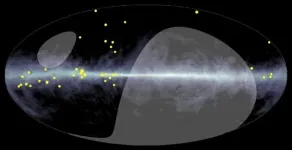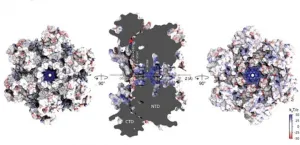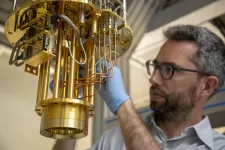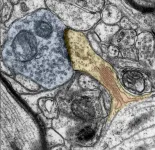(Press-News.org) An enormous telescope complex in Tibet has captured the first evidence of ultrahigh-energy gamma rays spread across the Milky Way. The findings offer proof that undetected starry accelerators churn out cosmic rays, which have floated around our galaxy for millions of years. The research is to be published in the journal Physical Review Letters on Monday, April 5.
"We found 23 ultrahigh-energy cosmic gamma rays along the Milky Way," said Kazumasa Kawata, a coauthor from the University of Tokyo. "The highest energy among them amounts to a world record: nearly one petaelectron volt."
That's three orders of magnitude greater than any known cosmic-ray-induced gamma ray--or any particle humans have accelerated in state-of-the-art laboratories on Earth.
Since 1990, dozens of researchers from China and Japan have hunted for the elusive high-energy cosmic gamma rays. The Tibet ASγ Collaboration made its discovery using nearly 70,000 square meters of ground arrays and underground muon detectors on the Tibetan Plateau, sitting more than 14,000 feet above sea level.
"Scientists believe high energy gamma rays can be produced by the nuclear interaction between high energy cosmic rays escaping from the most powerful galactic sources and interstellar gas in the Milky Way galaxy," said Huang Jing, a coauthor from Institute of High Energy Physics, Chinese Academy of Sciences.
Chen Ding of the National Astronomical Observatories, Chinese Academy of Sciences, another coauthor, added, "The detection of diffuse gamma rays above 100 teraelectron volts is a key to understanding the origin of very-high-energy cosmic rays, which has been a mystery since their discovery in 1912."
Balloon experiments first identified cosmic rays, revealing they were a key source of radiation on Earth. Cosmic rays are highly energetic particles, mostly protons, that travel across space. Millions of these particles pass through your body every day. (They are believed harmless.)
But where do cosmic rays come from?
"We live together with cosmic-ray muons, though we are usually not sensitive to them," said Kawata. "Isn't it a fantasy to think of where and how these cosmic rays are produced and accelerated, traveling all the way to Earth?"
A popular theory argues that accelerators known as "PeVatrons" spew cosmic rays at energies up to one petaelectron volt (PeV). Possible PeVatrons include supernova explosions, star-forming regions, and the supermassive black hole at the center of our galaxy.
So far, no one has detected any such accelerators. If PeVatrons exist, their cosmic rays should leave trails of glowing gamma rays strewn across the galaxy. The new study reports the first evidence of this highly-energetic haze.
"These gamma rays did not point back to the most powerful known high-energy gamma-ray sources, but spread out along the Milky Way," said Masato Takita, a coauthor and colleague of Kawata. "Our discovery confirms evidence of the existence of PeVatrons."
The researchers now want to determine if the probable PeVatrons are active or dead.
"From dead PeVatrons, which are extinct like dinosaurs, we can only see the footprint--the cosmic rays they produced over a few million years, spread over the galactic disk," said Takita.
"But if we can locate real, active PeVatrons, we can study many more questions," he said. "What type of star emits our sub-PeV gamma rays and related cosmic rays? How can a star accelerate cosmic rays up to PeV energies? How do the rays propagate inside our galactic disk?"
Other future directions include looking for PeVatron footprints in the southern hemisphere and confirming the gamma-ray results using neutrino detectors in Antarctica and beyond.
The research could also aid in the quest for dark matter. Underground detectors allowed the researchers to cut away cosmic-ray background noise, revealing the kind of pure, diffuse gamma rays predicted to emanate from dark matter.
"We can reduce the cosmic ray background by a factor of one million. Then we see a high-purity gamma ray sky," said Takita.
The experimental achievement moves physicists significantly closer to discovering where cosmic rays are born.
"This pioneering work opens a new window for the exploration of the extreme universe," said Huang. "The observational evidence marks an important milestone toward revealing cosmic ray origins, which have puzzled mankind for more than one century."
INFORMATION:
Press Conference Schedule
Researchers will participate in two press conferences on Friday, April 2, 2021:
-- APS will host an online press conference at 10:00 a.m. Eastern Daylight Time (EDT). Please click here to register.
-- The Tibet ASγ Collaboration will host an online press conference at 6:00 a.m. Greenwich Mean Time (GMT) / 3:00 p.m. JST (Japan Standard Time). Please contact icrr-pr@icrr.u-tokyo.ac.jp for details.
Reference
First Detection of Sub-PeV Diffuse Gamma Rays from the Galactic Disk: Evidence for Ubiquitous Galactic Cosmic Rays beyond PeV Energies
M. Amenomori et al. (The Tibet ASγ Collaboration), Phys. Rev. Lett.
A copy of the manuscript and DOI is available upon request.
Funding Information
The Tibet ASgamma Collaboration is composed of the following institutions: Hirosaki Univ., Nanjing Univ., IHEP / CAS, NAOC / CAS, Tibet Univ., Hebei Normal Univ., Univ. of Chinese Academy of Sciences, Shandong Univ., SouthWest Jiaotong Univ., Kanagawa Univ., Utsunomiya Univ., Shibaura Institute of Technology, Yokohama National Univ., Shinshu Univ., ICRR / Univ. of Tokyo, ISAS / JAXA, NCSW / CMA, Shandong Agriculture Univ., Univ. of Science and Technology of China, THCA, Tsinghua Univ., Joint Research Center for Astrophysics / Tsinghua Univ., Tsinghua Univ., NII, Shandong Management Univ., NICT, China Univ. of Petroleum, Tokyo Metropolitan College of Industrial Technology, Konan Univ., Nihon Univ., Shonan Institute of Technology, Waseda Univ., JAEA, and PMO / CAS.
This work was or is supported by Grants-in-Aid for Scientific Research on Priority Areas from the MEXT of Japan, Grants-in-Aid for Science Research from the JSPS of Japan, the National Key R&D Program of China, the National Natural Science Foundation of China, the Key Laboratory of Particle Astrophysics, IHEP, CAS, and the joint research program of the ICRR.
About APS
The American Physical Society is a nonprofit membership organization working to advance and diffuse the knowledge of physics through its outstanding research journals, scientific meetings, and education, outreach, advocacy, and international activities. APS represents over 55,000 members, including physicists in academia, national laboratories, and industry in the United States and throughout the world. Society offices are located in College Park, Maryland (Headquarters), Ridge, New York, and Washington, DC.
DURHAM, N.H.-- As the Biden administration announces a plan to expand the development of offshore wind energy development (OWD) along the East Coast, research from the University of New Hampshire shows significant support from an unlikely group, coastal recreation visitors. From boat enthusiasts to anglers, researchers found surprisingly widespread support with close to 77% of coastal recreation visitors supporting potential OWD along the N.H. Seacoast.
"This study takes a closer look at the lingering assumption that offshore wind in the United States might hurt coastal recreation ...
The first imaging of substantial freshwater plumes west of Hawai'i Island may help water planners to optimize sustainable yields and aquifer storage calculations. University of Hawai'i at Mānoa researchers demonstrated a new method to detect freshwater plumes between the seafloor and ocean surface in a study recently published in Geophysical Research Letters.
The research, supported by the Hawai'i EPSCoR 'Ike Wai project, is the first to demonstrate that surface-towed marine controlled-source electromagnetic (CSEM) imaging can be used to map oceanic freshwater plumes in high-resolution. It is an extension of the groundbreaking discovery of freshwater beneath the seafloor in 2020. Both are important findings in a world facing climate change, where ...
LOWELL, Mass. - Researchers studying mercury gas in the atmosphere with the aim of reducing the pollutant worldwide have determined a vast amount of the toxic element is absorbed by plants, leading it to deposit into soils.
Hundreds of tons of mercury each year are emitted into the atmosphere as a gas by burning coal, mining and other industrial and natural processes. These emissions are absorbed by plants in a process similar to how they take up carbon dioxide. When the plants shed leaves or die, the mercury is transferred to soils where large amounts also make their way into watersheds, threatening wildlife and people who eat contaminated fish.
Exposure to high levels of mercury over long ...
BRAZZAVILLE, Republic of Congo (March 31, 2021) - Researchers with the Wildlife Conservation Society's (WCS) Congo Program and the Nouabalé-Ndoki Foundation found that female putty-nosed monkeys (Cercopithecus nictitans) use males as "hired guns" to defend from predators such as leopards.
Publishing their results in the journal Royal Society Open Science, the team discovered that female monkeys use alarm calls to recruit males to defend them from predators. The researchers conducted the study among 19 different groups of wild putty-nosed monkeys, a type of forest guenon, in Mbeli Bai, a study area within the forests in Nouabalé-Ndoki National Park, Northern Republic of Congo.
The results promote the idea that females' general alarm requires males to assess the nature ...
(Denver, Colo., -- March 31, 2021)- A new Molecular Database Project initiated by the International Association for the Study of Lung (IASLC) will accelerate the understanding of lung cancer biology, clinical care and care delivery on a global scale and will improve the prognosis and optimal treatment of lung cancer across time and space, according to an editorial in the Journal of Thoracic Oncology, an official journal of the IASLC. The editorial can be viewed here: https://www.jto.org/article/S1556-0864(21)01781-0/fulltext.
In the editorial, the IASLC Staging and Prognostic Factors Committee's Molecular Sub-Committee, and committee members, emphasized that there is great opportunity, with the emergence of molecular biomarkers of disease behavior, to improve ...
Viruses lurk in the grey area between the living and the nonliving, according to scientists. Like living things, they replicate but they don't do it on their own. The HIV-1 virus, like all viruses, needs to hijack a host cell through infection in order to make copies of itself.
Supercomputer simulations supported by the National Science Foundation-funded Extreme Science and Engineering Discovery Environment (XSEDE) have helped uncover the mechanism for how the HIV-1 virus imports into its core the nucleotides it needs to fuel DNA synthesis, a key step in its replication. It's the first example ...
The qubit is the building block of quantum computing, analogous to the bit in classical computers. To perform error-free calculations, quantum computers of the future are likely to need at least millions of qubits. The latest study, published in the journal PRX Quantum, suggests that these computers could be made with industrial-grade silicon chips using existing manufacturing processes, instead of adopting new manufacturing processes or even newly discovered particles.
For the study, researchers were able to isolate and measure the quantum state of a single electron (the qubit) in a silicon transistor manufactured using a 'CMOS' technology similar to that used to make chips in computer processors.
Furthermore, the spin of the electron was found to remain stable for a period of up ...
Neuroscientists agree that a person's brain is constantly changing, rewiring itself and adapting to environmental stimuli. This is how humans learn new things and create memories. This adaptability and malleability is called plasticity. "Physicians have long suspected that remodeling processes also take place in humans at the contact points between nerve cells, i.e. directly at the synapses. Until now, however, such a coordinated adaptation of structure and function could only be demonstrated in animal experiments," says Prof. Dr. Andreas Vlachos from the Institute of Anatomy and Cell Biology at the University of Freiburg. But now Vlachos, together with Prof. Dr. Jürgen Beck, head of the Department of Neurosurgery at the University Medical Center Freiburg, has provided experimental evidence ...
Astronomers have detected X-rays from Uranus for the first time, using NASA's Chandra X-ray Observatory. This result may help scientists learn more about this enigmatic ice giant planet in our solar system.
Uranus is the seventh planet from the Sun and has two sets of rings around its equator. The planet, which has four times the diameter of Earth, rotates on its side, making it different from all other planets in the solar system. Since Voyager 2 was the only spacecraft to ever fly by Uranus, astronomers currently rely on telescopes much closer to Earth, like Chandra and the Hubble Space Telescope, to learn about this distant and cold planet that is made up almost entirely of hydrogen and helium.
In the new study, researchers used Chandra observations ...
In 1890, psychologist William James described attention as the spotlight we shine not only on the world around us, but also on the contents of our minds. Most cognitive scientists since then have drawn a sharp distinction between what James termed "sensorial attention" and "intellectual attention," now usually called "attention" and "working memory," but James saw them as two varieties of the same mental process.
New research by Princeton neuroscientists suggests that James was on to something, finding that attention to the outside world and attention to our own thoughts are actually two sides of the same neural coin. What's more, they have observed the coin as it flips inside the brain.
A paper published in Nature on March 31 by END ...







